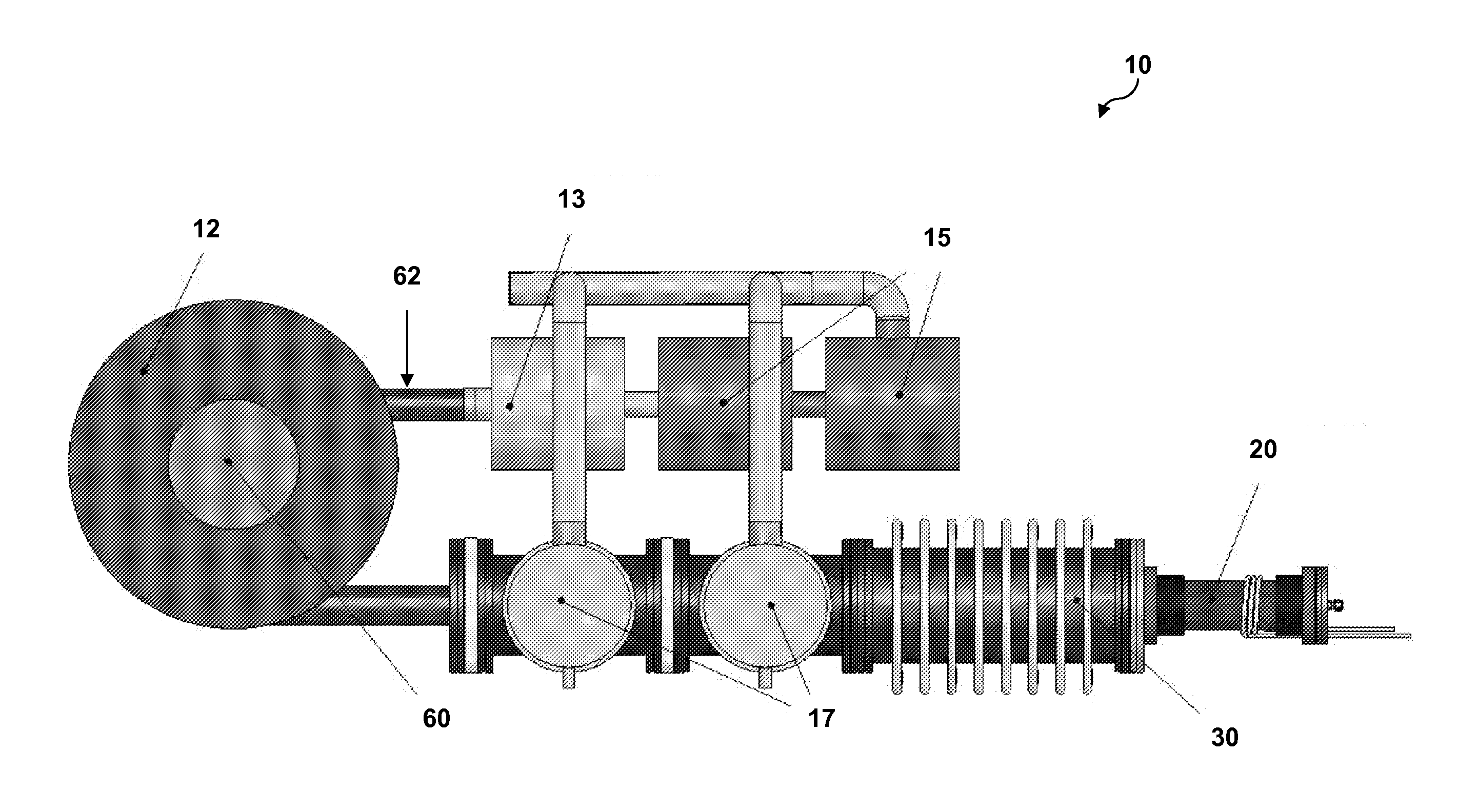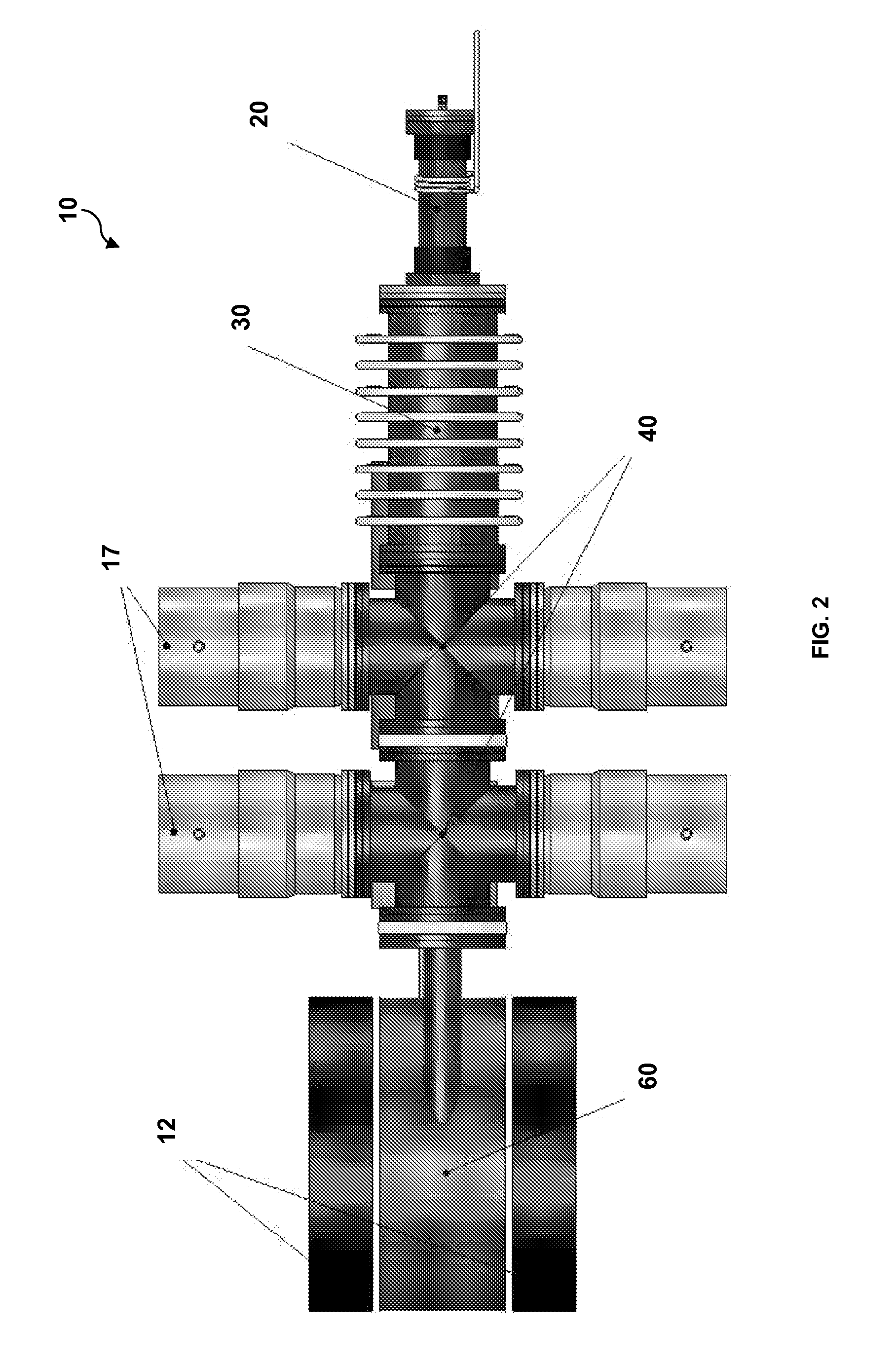High energy proton or neutron source
a proton or neutron source, high-energy technology, applied in chemical to radiation conversion, electrical apparatus, nuclear targets, etc., can solve the problems of high-energy radiation that requires special shielding facilities, large amount of high-energy radiation, and high cost of shielding facilities
- Summary
- Abstract
- Description
- Claims
- Application Information
AI Technical Summary
Benefits of technology
Problems solved by technology
Method used
Image
Examples
example 1
Neutron Source with Magnetic Target Chamber
[0077]Initially, the system will be clean and empty, containing a vacuum of 10−9 torr or lower, and the high speed pumps will be up to speed (two stages with each stage being a turbomolecular pump). Approximately 25-30 standard cubic centimeters of gas (deuterium for producing neutrons) will be flowed into the target chamber to create the target gas. Once the target gas has been established, that is, once the specified volume of gas has been flowed into the system and the pressure in the target chamber reaches approximately 0.5 torr, a valve will be opened which allows a flow of 0.5 to 1 sccm (standard cubic centimeters per minute) of deuterium from the target chamber into the ion source. This gas will re-circulate rapidly through the system, producing approximately the following pressures: in the ion source the pressure will be a few mtorr; in the accelerator the pressure will be around 20 μtorr; over the pumping stage nearest the accelera...
example 2
Neutron Source with Linear Target Chamber
[0080]Initially, the system will be clean and empty, containing a vacuum of 10-9 torr or lower and the high speed pumps will be up to speed (three stages, with the two nearest that accelerator being turbomolecular pumps and the third being a different pump such as a roots blower). Approximately 1000 standard cubic centimeters of deuterium gas will be flowed into the target chamber to create the target gas. Once the target gas has been established, a valve will be opened which allows a flow of 0.5 to 1 sccm (standard cubic centimeters per minute) from the target chamber into the ion source. This gas will re-circulate rapidly through the system, producing approximately the following pressures: in the ion source the pressure will be a few mtorr; in the accelerator the pressure will be around 20 μtorr; over the pumping stage nearest the accelerator, the pressure will be <20 μtorr; over the center pumping stage the pressure will be ˜50 mtorr; over...
example 3
Proton Source with Magnetic Target Chamber
[0084]Initially, the system will be clean and empty, containing a vacuum of 10−9 torr or lower, and the high speed pumps will be up to speed (two stages with each stage being a turbomolecular pump). Approximately 25-30 standard cubic centimeters of gas (an approximate 50 / 50 mixture of deuterium and helium-3 to generate protons) will be flowed into the target chamber to create the target gas. Once the target gas has been established, that is, once the specified volume of gas has been flowed into the system and the pressure in the target chamber reaches approximately 0.5 torr, a valve will be opened which allows a flow of 0.5 to 1 sccm (standard cubic centimeters per minute) of deuterium from the target chamber into the ion source. This gas will re-circulate rapidly through the system, producing approximately the following pressures: in the ion source the pressure will be a few mtorr; in the accelerator the pressure will be around 20 μtorr; ov...
PUM
 Login to View More
Login to View More Abstract
Description
Claims
Application Information
 Login to View More
Login to View More - R&D
- Intellectual Property
- Life Sciences
- Materials
- Tech Scout
- Unparalleled Data Quality
- Higher Quality Content
- 60% Fewer Hallucinations
Browse by: Latest US Patents, China's latest patents, Technical Efficacy Thesaurus, Application Domain, Technology Topic, Popular Technical Reports.
© 2025 PatSnap. All rights reserved.Legal|Privacy policy|Modern Slavery Act Transparency Statement|Sitemap|About US| Contact US: help@patsnap.com



